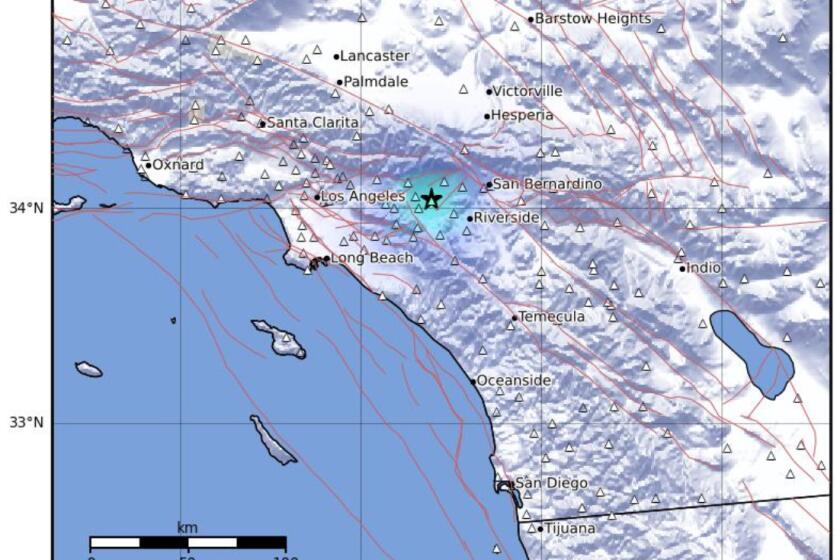PERSPECTIVE ON EARTHQUAKE PREPAREDNESS : If the Next One Hits at Rush Hour . . . : Hospitals may be full--or destroyed. We need a plan for “MASH”-type centers to deal with thousands of emergencies.
Only 57 dead, a few thousand injured, hundreds of them seriously enough to be hospitalized. Just four hospitals evacuated because of earthquake damage.
In the aftermath of one of the most destructive natural events to strike California in the 20th Century, it appears that once again we escaped catastrophe in the delivery of medical care. Proving the adage that “it’s more important to be lucky than good,” sufficient emergency medical care was provided despite the lack of a comprehensive medical disaster response plan.
This does not imply that those in the emergency medical services system are not doing their job. Quite the contrary, Los Angeles is blessed with an abundance of dedicated and skilled personnel. Rather, it is the assumption that hospitals should be the sole provider of “disaster medical care” that is flawed.
Currently, there is only one medical disaster response plan: Take the injured to the hospital. But we know that there may be no hospital, or no way to get to it. Many people won’t survive the 72-hour wait until sufficient help arrives from outside the area. We know that within six hours following an earthquake, people with serious but treatable medical problems will begin dying if they do not receive advanced care. If untreated, in 24 to 48 hours these potential survivors will perish.
This is exactly what will happen unless alternatives to traditional centralized care facilities are developed.
As can be seen in the Northridge quake, hospitals are vulnerable. A closer look at what happened illustrates how fortunate we were. On first inspection, the delivery of medical care seemed adequate. No one died waiting in line at emergency rooms. Patients with serious problems got prompt care. Damaged hospitals transferred their patients without serious incident. So why the concern?
If the upheaval had occurred instead at 4:30 p.m., the sheer volume of injured victims would have drastically increased. The freeways, parking structures, shopping centers and office buildings that collapsed would have been swarming with people. Many thousands would have been trapped and critically injured. Hundreds more would have less significant injuries requiring immediate care.
There wouldn’t be nearly enough resources to handle patients already hospitalized--who would have to be evacuated--and the new quake victims. Delays would kill people. This wasn’t the “Big One,” but had it struck 12 hours later, it would have been big enough.
A practical solution is possible. Clearly, hospitals are crucial, but they must be supported by an additional form of medical response that can be activated within the first hour and function even if the hospitals are destroyed. Concerned emergency physicians have devised such a plan, relying on the pre-positioning of advanced medical equipment in community disaster medical-aid centers staffed by doctors and nurses trained in the “out-of-hospital” management of disaster victims. The money to implement the plan hasn’t been found.
The plan calls for putting stores of medical supplies in facilities most likely to survive earthquakes, such as fire stations and schools. Most of these structures are within an hour’s walk of everyone, so they are accessible even if the transportation system fails. The supplies would be periodically exchanged with hospitals to prevent spoilage. Training for health-care providers is already available through a nonprofit corporation called Medical Disaster Response.
A disaster declaration would direct medical personnel not required at hospitals to the disaster centers. Patients with mild to moderate injuries and illnesses would be treated on location. Those seriously ill would be stabilized and, if hospitals are still functional, transferred there. If no hospital care is available, patients would be moved to predetermined “casualty collection points,” and from there to facilities outside the disaster area. If the local hospital is intact, only the seriously injured are sent there. If it is not, valuable time is not wasted.
One city in the Los Angeles area, Santa Fe Springs, has already begun this strategy. It is divided into four areas, each having its own cache of equipment, to which citizens and trained personnel will report when disaster strikes.
Our memory of this frightening event will begin to fade as the aftershocks diminish, but the threat remains. The state Department of Conservation predicts a magnitude 7.5 quake producing an estimated 100,000 casualties within our lifetimes. This time around, we dodged the bullet, but next time our luck may run out. Until a realistic disaster medical plan is in place, we remain at risk. One need not look too closely to see the emperor still has no clothes.
More to Read
Sign up for Essential California
The most important California stories and recommendations in your inbox every morning.
You may occasionally receive promotional content from the Los Angeles Times.










